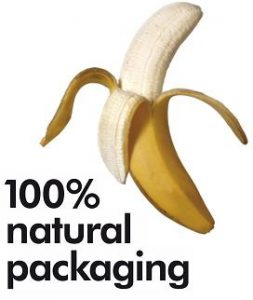Reduce Think Packaging
A fifth of our waste is packaging – that’s five million tonnes of household packaging waste in the UK every year
Packaging is needed to protect products, particularly food, but too much is a big waste! So next time you are out shopping remember to Think Packaging!

Why is packaging needed?
Packaging helps to protect products and can help food to last longer, which helps to reduce waste. Unwrapped cucumbers are often un-saleable after three days, but using just under 2 grams of packaging can keep them fresh for up to 14 days. Packaging is also needed to transport products without damaging them.
The problem with excess packaging
Even though some packaging is necessary, a lot of products have excess packaging which can mean the product costs more. Packaging is also often sent for disposal as it can be difficult to reuse or recycle.
Most products with excess packaging could use less, or smarter packaging, such as recyclable material, to give the same amount of protection.
There are now new regulations – Extended Producer Responsibility for Packaging (pEPR) – which incentivises producers to make better more sustainable decisions in the design and use of packaging. See pEPR details below for further information.
What can we do?
Here are some tips to help cut down on packaging and what you can do with the packaging that is necessary:
Reducing packaging
- Look for products with less packaging; many companies are promoting how much they’ve reduced their packaging. Products with no packaging, such as loose fruit and veg, are even better!
- Buy products that use recycled packaging and can be recycled in your local area
- Buy concentrated products and refill packs instead of fully packaged products, such as fabric conditioner, washing powders and some beauty products – this can save you money too!
- Where possible, buy larger or economy sizes of goods such as breakfast cereal, tomato ketchup, toilet rolls and soap powder. This can save money and creates less packaging in the long run
Reusing packaging
- Use plastic ice cream tubs for storing leftover food in the fridge
- Paint old jam jars with glass paints to make nightlights, or use them to store homemade chutneys
- Use empty biscuit tins to store spare buttons or screws
- Create works of art with your children using empty cereal boxes, crisp packets and plastic bottles
- Grow seedlings in empty yogurt pots
Recycling packaging
- Cans and tins – Your steel and aluminium food tins and drinks cans are widely recycled. Don’t forget to rinse them out first
- Glass – Glass is widely recycled. Don’t forget that as well as wine and beer bottles you can recycle sauce jars, coffee jars and even Marmite jars
- Cardboard – Cardboard packaging can be recycled too. Things like cereal boxes, ready meal sleeves and tea bag boxes can all be recycled
- Plastic bottles – These are widely recycled. Don’t forget you can recycle things like shampoo and bleach bottles as well
- Other plastic – Item such as yogurt pots and margarine tubs can be recycled at your local Recycling and Household Waste Site. Don’t forget to recycle your plastic food trays too. Some kerbside recycling collections may also collect these materials
- Plastic bags – Reuse your plastic bags where possible but if you need to dispose of them they can be recycled at most Recycling and Household Waste Sites and supermarkets
How to complain about excessive packaging
If you spot an item which you think has excessive packaging you can complain about it, which should encourage the manufacturer to look into reducing their packaging. You can complain in the following ways:
- Write to the supermarket or manufacturer to complain, asking why they are using so much packaging
- Contact Trading Standards who can investigate your complaint. They will also be able to consider if the packaging is deliberately misleading in making you think there is more product in the pack than there actually is. Email: tradingstandards@leics.gov.uk or visit; http://www.leicestershire.gov.uk/business-and-consumers/trading-standards
What retailers are doing to help
- Introduced in 2005, the Courtauld Commitment is a voluntary agreement between WRAP (Waste and Resources Action Programme) and various grocery retailers, suppliers and leading brands who have signed up with the intention of reducing food and packaging waste
- As a result, 670,000 tonnes of food waste and 520,000 tonnes of packaging were avoided between 2005 and 2009
- The second stage, launched in March 2012 focuses on using sustainable resources
- Here are some examples of changes made by various supermarkets:
- Toilet roll diameter reduced by 12mm, cutting the number of delivery lorries required by the equivalent of 140,000 kg of CO2.
- Tray-less bags for chickens has reduced packaging by 68%, which means 540 fewer vehicles on the road.
- Tomato puree tubes no longer come in cartons, reducing packaging by 45%
- Lightening wine bottles by 30%, reducing glass usage by 560t a year
- Replacing glass peanut butter jars with plastic, cutting packaging by 83%
- Reducing the cardboard on pizza base mix, saving 87% of packaging
Extended Producer Responsibility for Packaging (pEPR)
- pEPR incentivises producers to make better more sustainable decisions in the design and use of packaging and moves the full net cost of dealing with packaging waste generated by households from local taxpayers and councils to businesses that place packaging on the market. These businesses will be obliged to pay these costs to local authorities (LAs).
- pEPR will cover the following packaging materials: Aluminium, fibre-based composites, paper or board, plastic, steel, wood, glass and other (e.g. bamboo, cork, ceramics).
- Potential benefits of pEPR include increased recycling rates by encouraging producers to design easier to recycle packaging, as producers will pay more for items that are harder to recycle. It should also encourage innovation such as innovative packaging solutions that are more sustainable and recyclable.
Also in Reduce Sub menu










